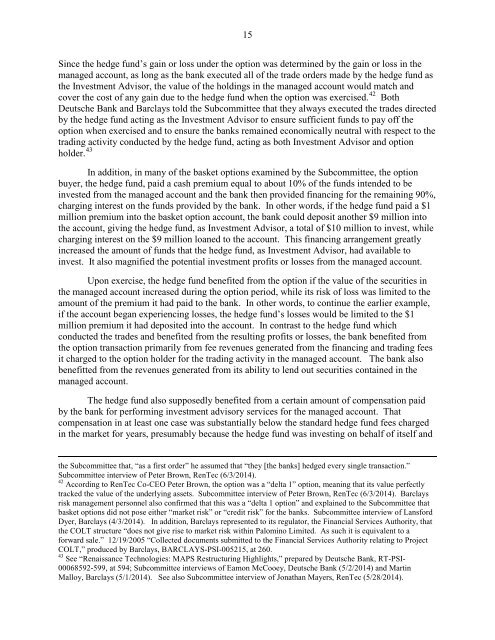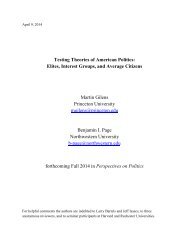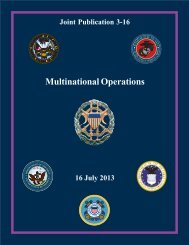ABUSE OF STRUCTURED FINANCIAL PRODUCTS- Misusing Basket Options to Avoid Taxes and Leverage Limits MAJORITY AND MINORITY STAFF REPORT
ABUSE OF STRUCTURED FINANCIAL PRODUCTS- Misusing Basket Options to Avoid Taxes and Leverage Limits MAJORITY AND MINORITY STAFF REPORT
ABUSE OF STRUCTURED FINANCIAL PRODUCTS- Misusing Basket Options to Avoid Taxes and Leverage Limits MAJORITY AND MINORITY STAFF REPORT
Create successful ePaper yourself
Turn your PDF publications into a flip-book with our unique Google optimized e-Paper software.
15<br />
Since the hedge fund’s gain or loss under the option was determined by the gain or loss in the<br />
managed account, as long as the bank executed all of the trade orders made by the hedge fund as<br />
the Investment Advisor, the value of the holdings in the managed account would match <strong>and</strong><br />
cover the cost of any gain due <strong>to</strong> the hedge fund when the option was exercised. 42 Both<br />
Deutsche Bank <strong>and</strong> Barclays <strong>to</strong>ld the Subcommittee that they always executed the trades directed<br />
by the hedge fund acting as the Investment Advisor <strong>to</strong> ensure sufficient funds <strong>to</strong> pay off the<br />
option when exercised <strong>and</strong> <strong>to</strong> ensure the banks remained economically neutral with respect <strong>to</strong> the<br />
trading activity conducted by the hedge fund, acting as both Investment Advisor <strong>and</strong> option<br />
holder. 43<br />
In addition, in many of the basket options examined by the Subcommittee, the option<br />
buyer, the hedge fund, paid a cash premium equal <strong>to</strong> about 10% of the funds intended <strong>to</strong> be<br />
invested from the managed account <strong>and</strong> the bank then provided financing for the remaining 90%,<br />
charging interest on the funds provided by the bank. In other words, if the hedge fund paid a $1<br />
million premium in<strong>to</strong> the basket option account, the bank could deposit another $9 million in<strong>to</strong><br />
the account, giving the hedge fund, as Investment Advisor, a <strong>to</strong>tal of $10 million <strong>to</strong> invest, while<br />
charging interest on the $9 million loaned <strong>to</strong> the account. This financing arrangement greatly<br />
increased the amount of funds that the hedge fund, as Investment Advisor, had available <strong>to</strong><br />
invest. It also magnified the potential investment profits or losses from the managed account.<br />
Upon exercise, the hedge fund benefited from the option if the value of the securities in<br />
the managed account increased during the option period, while its risk of loss was limited <strong>to</strong> the<br />
amount of the premium it had paid <strong>to</strong> the bank. In other words, <strong>to</strong> continue the earlier example,<br />
if the account began experiencing losses, the hedge fund’s losses would be limited <strong>to</strong> the $1<br />
million premium it had deposited in<strong>to</strong> the account. In contrast <strong>to</strong> the hedge fund which<br />
conducted the trades <strong>and</strong> benefited from the resulting profits or losses, the bank benefited from<br />
the option transaction primarily from fee revenues generated from the financing <strong>and</strong> trading fees<br />
it charged <strong>to</strong> the option holder for the trading activity in the managed account. The bank also<br />
benefitted from the revenues generated from its ability <strong>to</strong> lend out securities contained in the<br />
managed account.<br />
The hedge fund also supposedly benefited from a certain amount of compensation paid<br />
by the bank for performing investment advisory services for the managed account. That<br />
compensation in at least one case was substantially below the st<strong>and</strong>ard hedge fund fees charged<br />
in the market for years, presumably because the hedge fund was investing on behalf of itself <strong>and</strong><br />
the Subcommittee that, “as a first order” he assumed that “they [the banks] hedged every single transaction.”<br />
Subcommittee interview of Peter Brown, RenTec (6/3/2014).<br />
42 According <strong>to</strong> RenTec Co-CEO Peter Brown, the option was a “delta 1” option, meaning that its value perfectly<br />
tracked the value of the underlying assets. Subcommittee interview of Peter Brown, RenTec (6/3/2014). Barclays<br />
risk management personnel also confirmed that this was a “delta 1 option” <strong>and</strong> explained <strong>to</strong> the Subcommittee that<br />
basket options did not pose either “market risk” or “credit risk” for the banks. Subcommittee interview of Lansford<br />
Dyer, Barclays (4/3/2014). In addition, Barclays represented <strong>to</strong> its regula<strong>to</strong>r, the Financial Services Authority, that<br />
the COLT structure “does not give rise <strong>to</strong> market risk within Palomino Limited. As such it is equivalent <strong>to</strong> a<br />
forward sale.” 12/19/2005 “Collected documents submitted <strong>to</strong> the Financial Services Authority relating <strong>to</strong> Project<br />
COLT,” produced by Barclays, BARCLAYS-PSI-005215, at 260.<br />
43 See “Renaissance Technologies: MAPS Restructuring Highlights,” prepared by Deutsche Bank, RT-PSI-<br />
00068592-599, at 594; Subcommittee interviews of Eamon McCooey, Deutsche Bank (5/2/2014) <strong>and</strong> Martin<br />
Malloy, Barclays (5/1/2014). See also Subcommittee interview of Jonathan Mayers, RenTec (5/28/2014).







